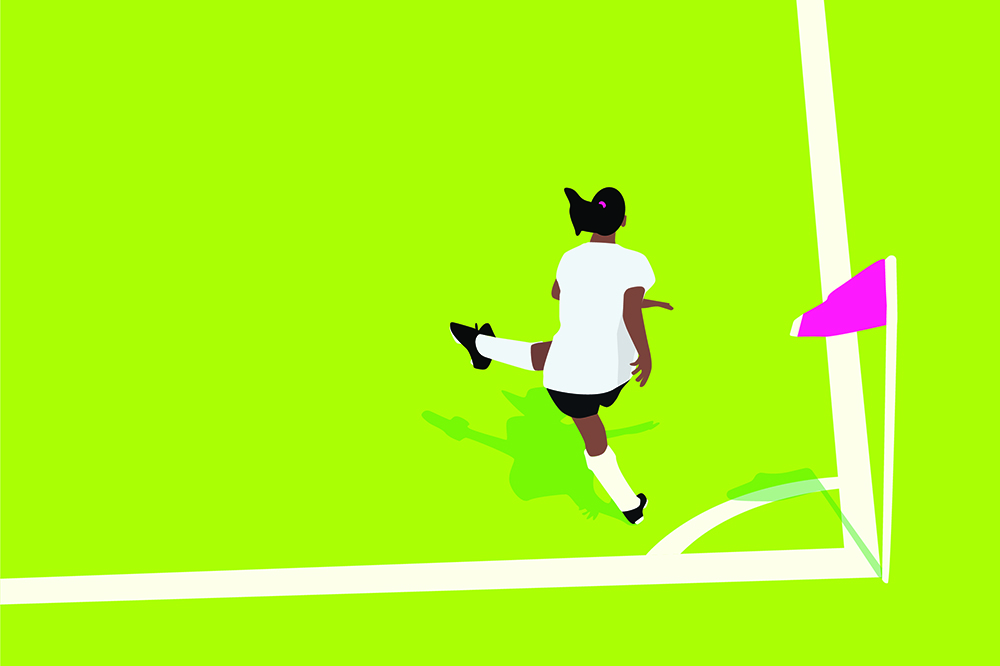A Beginner’s Guide to Soccer

I won’t do the cliché, “Ever since I was born, I had a soccer ball at my feet,” because frankly, who really remembers that? I don’t. But, I can say that ever since I remember playing outside, I was playing soccer. Growing up, weeks were devoted to balancing competing soccer team commitments. On the weekends, I remember loading up the car early in the morning with my dad and bagel order (egg bagel toasted with butter — I promise you that’s evolved since) in hand, then returning in the evening with the windows down all the way to let that epic, post-victory shin guard stench out.
On to college, and club soccer was the name of the game for me. With that, I made lifelong friends who took me into my life here in the DMV, and you guessed it — more soccer teams. Early on, I remember at one point playing on four different soccer teams, while subbing here and there when I could for others, and then throwing in the weekend soccer game viewing of the English Premier League. But it was through these teams and this city’s love of soccer, that over the last decade, I’ve made friends who are family, met my husband, and — wait for it — had a baby. So now, full circle, said baby is just shy of six months old. Does she have a soccer ball at her feet? Well yeah, duh.
The Basics
A professional soccer game is 90 minutes, or two 45-minute halves, with each team comprised of 11 players. There’s a goalkeeper, who guards the goal and is the only player on the field allowed to use their hands within the confines of the goalie box; defenders, who are in front of the goalkeeper and help defend the goal; midfielders, who are in front of the defenders connecting the defensive play to the offensive play; and forwards, who are at the top of a team’s formation and tend to be the goal scorers, although really any team member can score. During the game, your team is trying to work the ball into the opposing team’s side of the field and eventually score on their goal. All the while, you are also trying to avoid the opposing team from scoring on your goal. À la John Madden, at the end of the game, the team with the most goals is going to win. Here are a few basic calls/stop of plays you’ll encounter.
Throw In: Okay, so I lied: Field players use their hands just this once. When the ball goes out of bounds on either sideline, a throw-in is taken by the opponents of the player who last touched the ball.
Goal Kick: When the ball goes out of bounds by crossing the goal line and the last person to touch the ball was the attacking team, the defending team takes the goal kick from anywhere inside the goal area box. The ball must leave the penalty area before anyone can touch the ball.
Corner Kick: When the ball goes out of bounds by crossing the goal line and the last person to touch the ball was the defending team, the attacking team takes the kick from the corner nearest to where the ball went out and can score off the kick itself (my personal favorite from the right side via my left foot) or have a teammate in the goalie box area ready to knock that ball into the net.
Offsides: Many salt and pepper shakers and ketchup bottles have been used to explain this to colleagues and friends over the last few years, but here I go without those items. A player is in an “offsides position” if they are in the opposing team’s half and behind the last defender and the ball. “Offsides” is called on a player when the player is in the offsides position while the ball is passed forward to them.
Indirect and Direct Kick: A referee calls a foul on a player and depending on the referee’s views of the severity of the foul, the opposing team gets a free kick from the spot the foul was called: a direct kick, which means the player who is kicking the ball can score a goal off of the kick, or an indirect kick, which means the ball has to touch two players before a goal is scored off of the kick.
Penalty Kick: When a player commits a foul in their own penalty box, the referee, to the dismay of the team “committing the foul,” awards the opposing team a penalty kick (immediate debate ensues). The ball is placed on the penalty line and the player who was fouled takes a single kick against just the goalkeeper.
Tips from Players
Describe the soccer obsession.
Max Olson: There are so many opportunities to play soccer. Whether you want to play on a relaxed co-ed team, over 40s or a really competitive team, there is something for everyone. There’s lots of great places to get together and watch games, too.
What is the best way for someone to find a soccer team to join in the area?
Jahleel Hudson: Soccer is so popular in the that just about everyone has a coworker who plays in some sort of league. The next step is to look online at Fray and the other recreational sports leagues. Fray has an option for newcomers to the area to register as a free agent. The soccer scene is friendly. If you happen to be walking by a league match, someone will offer to tell you the details of how to join.
What one can someone do to improve their game?
Katie Owings: For ball work, start with the basics. Work on passing and shooting where you are striking the ball with the correct part of your foot. You can shoot on an empty net or pass against a wall. Work on one-touch passes back to the wall and also try controlling the ball with one to two touches as it comes back at you. Cone work is another great starting point. Work on dribbling and cutting at cones or weaving through cones while controlling the ball. For exercises without the ball, again, work on your agility: lots of cutting and quick changes of direction are essential. Also, suicides (mixes of sprints at different distances) help replicate the constant speed changes of the game.
Enjoy this piece? Consider becoming a member for access to our premium digital content. Support local journalism and start your membership today.

